Can you travel from the island nation of Indonesia to the mainland without using airplanes? The answer is yes. Why might you need this? First of all, it's one way to thoroughly explore the country, which consists not only of the resort island of Bali. Secondly, you might have a dislike for airplanes, for any number of reasons. The important thing is that it's achievable.
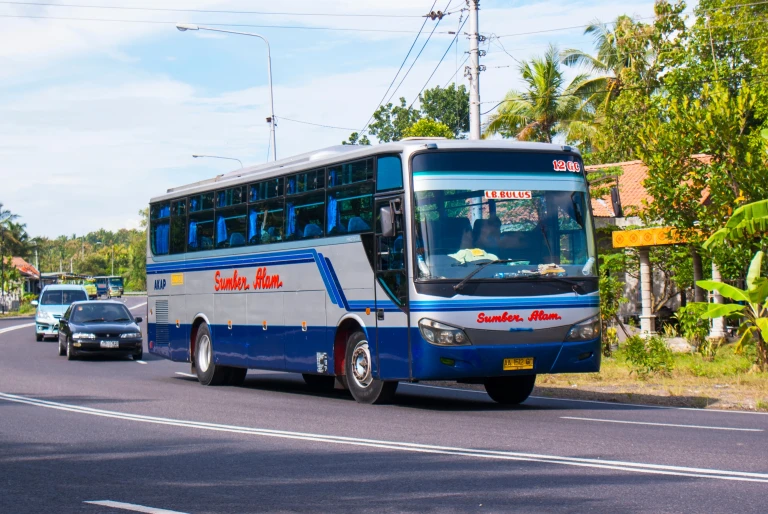
In this article, I'll describe a journey using public transportation: trains, buses, and ferries. Ferries in this case will be included in the cost of bus transfers, so they won't pose any additional challenges.
I'll say right away that traveling by plane is often cheaper and more comfortable. However, traveling by bus allows you to experience the country's atmosphere fully and see much more out of the window than you would from a plane's window. Moreover, you can create a journey with small transfers and large ethnographic excursions to various city locations and natural landmarks. In short, complete immersion.
How do you prepare?
It's worth preparing in advance for a journey by land. You'll need warm clothing and closed-toe shoes. Buses are often quite cold, so a warm hoodie, jeans, and sneakers will be just right. Also, a neck pillow and sleep mask will come in handy. It's worth bringing a powerful power bank, headphones, preferably with noise cancellation, an e-reader, basically everything you might need for a multi-hour journey. In many buses, each seat is equipped with USB chargers or there are sockets, usually hidden in the luggage compartments. Also, you'll likely be given a pillow and a blanket. During the journey, be prepared to use a translator on your phone, as most locals demonstrate a complete lack of knowledge of English, and other languages, except Indonesian. Make sure you have enough internet on your phone, take with you 500,000 - 1,000,000 in cash, and of course, a bank card. It's convenient to have a small bag or backpack that you can take with you into the bus cabin, leaving the main suitcase or backpack in the luggage compartment. Most buses have a toilet. Counting on being able to use it seriously is not worth it. Even dealing with minor tasks in such a toilet resembles an impressive circus acrobatics act. Typically, buses stop at roadside restaurants every 4-6 hours for about 60 minutes. Overall, don't expect much comfort from bus travel. Often, it's a test of your endurance, patience, and even your existence. Sometimes, on the contrary, you find yourself in an excellent bus with business class-level seats and wonderful quiet neighbors. All this happens randomly, and it's impossible to predict in advance the level of discomfort you might experience. But don't travel on buses where the ticket prices are very low and the travel time is significantly longer than for others. They will stop at every house along the way, make you wait for hours in the middle of nowhere, and people with guitars, bears, and other gypsies, as well as various inedible foods, will constantly intrude into the cabin... Although, it sounds like a separate form of entertainment, you can try it once, maybe you'll like it.
Try to plan your route so that bus transfers are not very long, and you have a day or two or more between journeys to rest. In large Indonesian cities, there's always something to do, so you won't be bored. The cities on Java that are good for a stopover are: Surabaya, Semarang, Yogyakarta, Bandung, Jakarta. I'll add Malang to the list. As a city, it's not particularly interesting, but you can rent a bike there and ride through the foothills and caldera of Bromo, which is very picturesque.
From Bali to Java
To leave Bali, we'll take a bus that departs from Mengwi station.
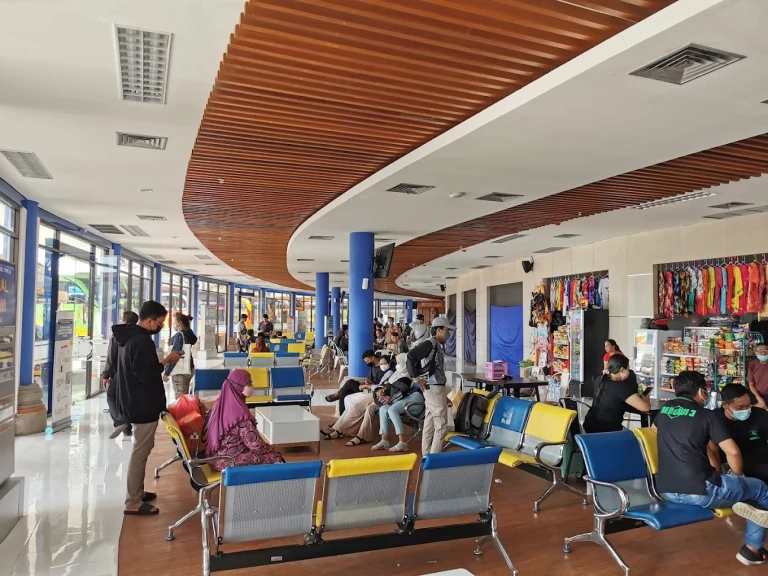
The station is located quite far from the tourist areas, so to get there, you'll need to use online taxi services or get help from a friend. The road from Denpasar to the station will take about 50 minutes and will cost around 50,000 for Gojek and around 140,000 for GoCar.
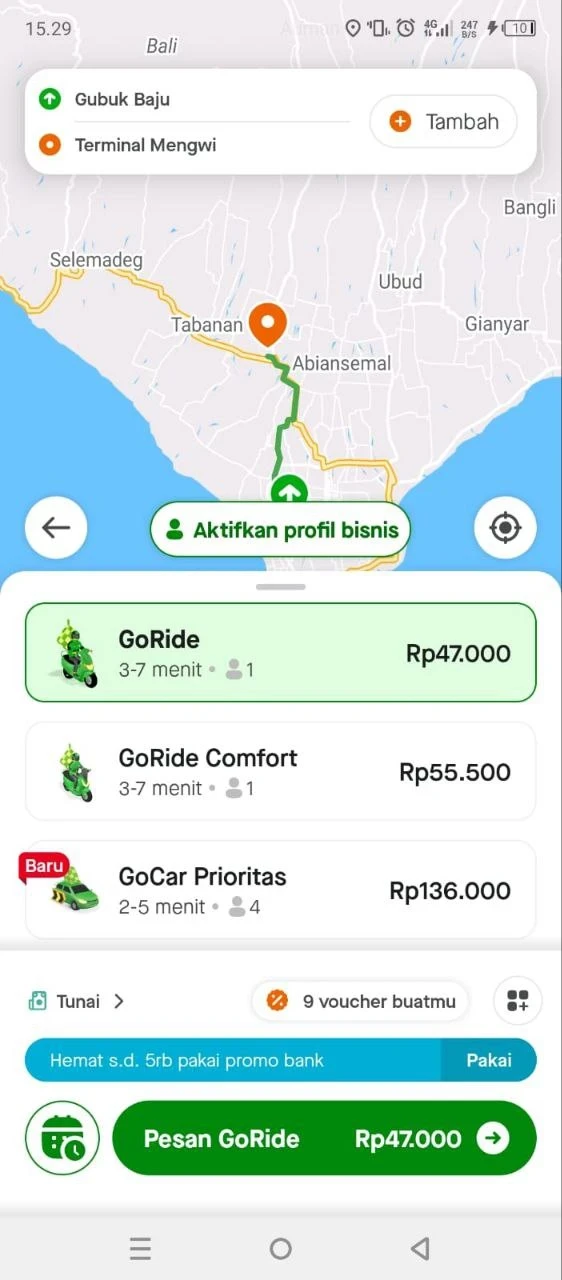
Of course, before heading to the station, you'll need to choose the city that interests you on the neighboring island of Java. Generally, Indonesia is well-connected by bus routes, and you can easily find a bus to any major city. You can use the Traveloka app to search for and purchase tickets. Choose the bus, enter the name of the city, and you'll get a list of routes, departure times, and approximate travel times. In the screenshot, you can see that the journey from Bali to Yogyakarta in central Java will take 15 hours. Most likely, the trip will take longer. Buses in Indonesia tend to be late. 15 hours is a long time. But if you take an evening bus that will be on the road all night, you can just sleep through half of the journey. Of course, if you can sleep in aggressively moving transport on not the best quality roads. The seats on the buses recline and can be quite comfortable. When choosing a bus, pay attention to the company's rating and, of course, the cost. For example, prices for this journey range from 780,000 to 450,000 rupiah, and it's evident that the rating for the expensive routes is quite low.
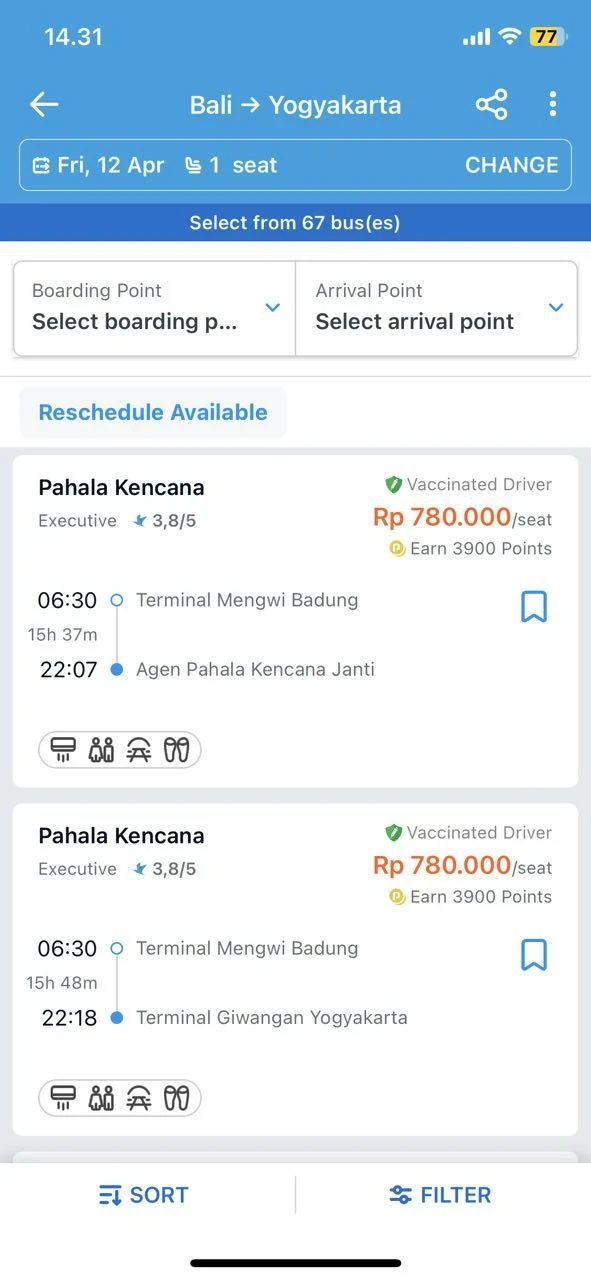
On Java, you can also travel by railway. Javanese trains are quite clean, comfortable, and punctual. Tickets are also purchased through Traveloka. By the way, this service can be paid not only by card but also through stores like Indomaret, Alfamart, etc. I'll note that train tickets should be bought in advance. If a bus ticket can be purchased literally a day or two before the trip, it's better to book a train ticket a week in advance. Traveling by train is more comfortable and faster than by bus. Unfortunately, there aren't as many railway lines in Indonesia as one would like. To get on a Javanese train, you'll have to travel from Bali to one of the nearby cities, Surabaya or Banyuwangi. There's no railway on the Island of the Gods yet. But soon there should be a metro.
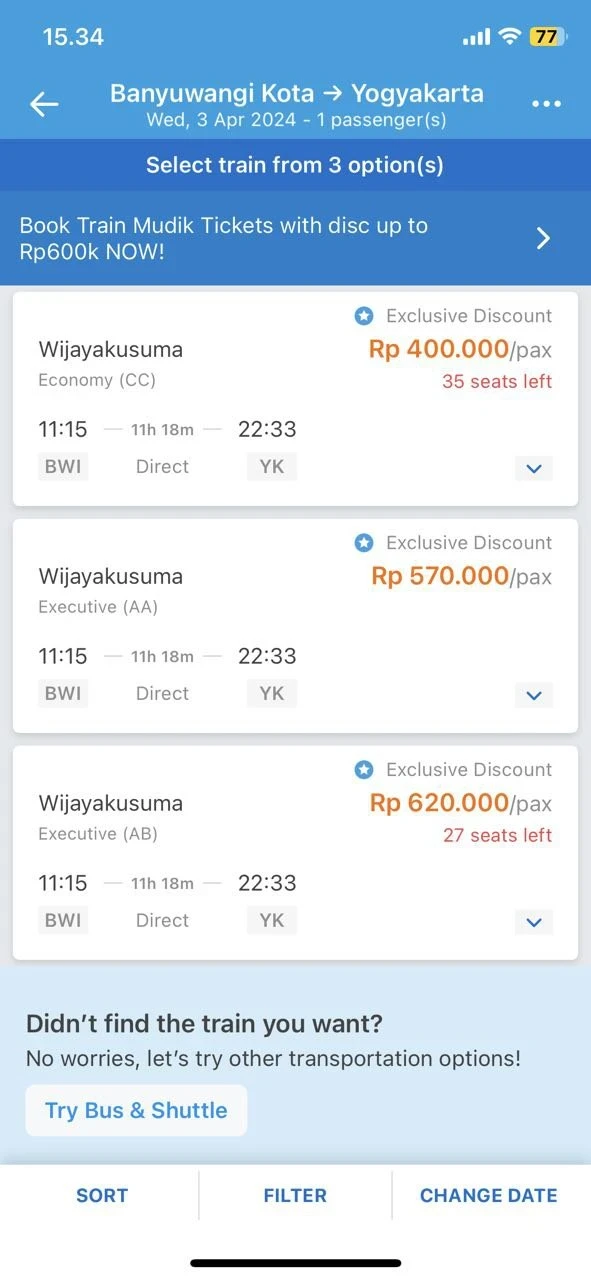
From Java to Sumatra
Java is good, but we were going to reach all the way to Malaysia. To cross the Malacca Strait and reach Malaysia, the next country on our route, we'll need a ferry. It departs from the small town of Dumai in Sumatra. To get there, we'll need to reach the city of Pekanbaru. Since there's no single railway line on one of the largest islands in the world, we'll have to use a bus. In principle, from any major city in western Java, there's a bus to Pekanbaru. Keep in mind that even from Jakarta, which is almost on the far west of Java, close to Sumatra, this route will take around 36-40 hours. Earlier, this trip took about 50 hours, but now several expressways have been built on Sumatra, reducing travel time. However, it's still intimidating. So it's better to break this route into several smaller segments. The principle is the same - major cities are good for stopovers. Bandar Lampung, Palembang, Jambi. In Sumatra, it's worth staying for a few days, if only to see that Indonesian food can be much tastier than in Bali and Java, not to mention that portions can also be larger. As for natural beauty, it's mostly on the west coast. On the east, you'll mostly find palm plantations and oil rigs.
Once you're in Pekanbaru, you can buy a ticket to Dumai at the bus station. Buses run quite frequently, but you can't buy a ticket through Traveloka. You need to ask the guards at the entrance to the terminal building where the ticket office to Dumai is located.
From Sumatra to Malaysia
The ferry from Dumai to the beautiful Malaysian city of Malacca departs in the morning, around 9 am, so most likely, you'll have to spend the night in Dumai. I recommend, for example, the City Hotel, which is located near the ticket counters, where you can buy a ferry ticket in the morning. It costs around 600,000 rupiahs one way. If you plan to return by sea within six months, it's better to buy a return ticket right away, it'll be a bit cheaper. To enter Malaysia, you now need to fill out an online form, so save the email you receive on your phone, just in case. When crossing the border, you won't need anything else except your passport.
You'll be taken to the seaport directly from the INDOMALL express counter where you bought the ticket. You'll need about 70,000 rupiahs in cash to pay the port fee, then the usual procedure with your passport and immigration, exit stamp, and that's it, just get on the ferry and prepare motion sickness pills if you have any problems with that.
After 3-4 hours, you'll be unloaded at the passenger port of Malacca, Malaysia. You can purchase a SIM card there. Indonesian operators will stop working if you didn't purchase roaming in advance. There's a Grab online taxi network in the country, so you can use the app you already have installed in Indonesia. That's it, you've arrived, welcome to the mainland. From here, it's easy to travel overland to any country, whether it's Thailand, Cambodia, or Vietnam. But I suppose by this time, you'll be quite tired of buses and prefer a plane. And that's a mistake, Malaysian buses are wonderful compared to Indonesian ones. You can use the easybook.com app for traveling by bus. There's a bus terminal in every city, from where intercity buses depart. There are even international options - you can leave from Malacca straight to Thailand.
You can add one right now!